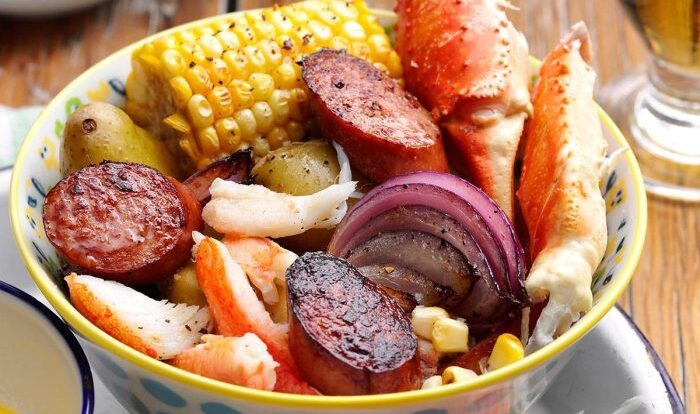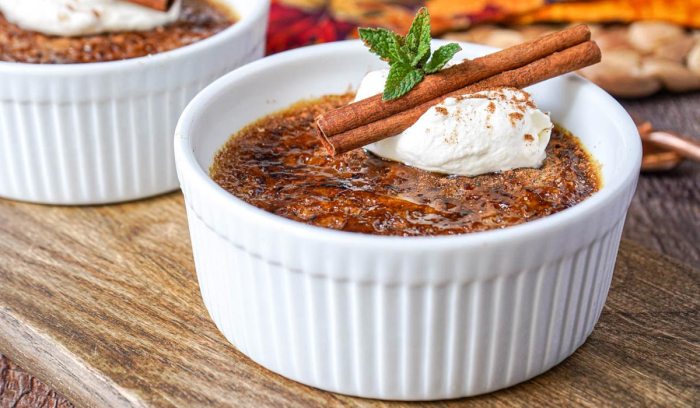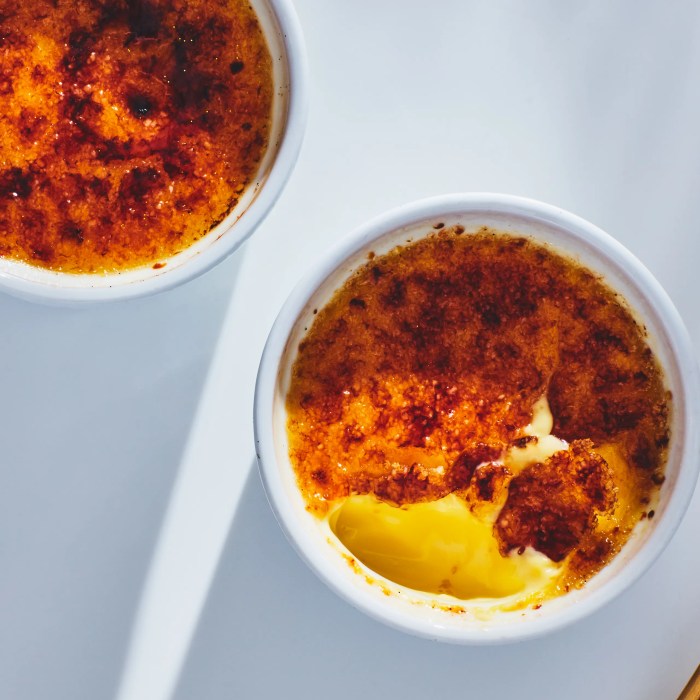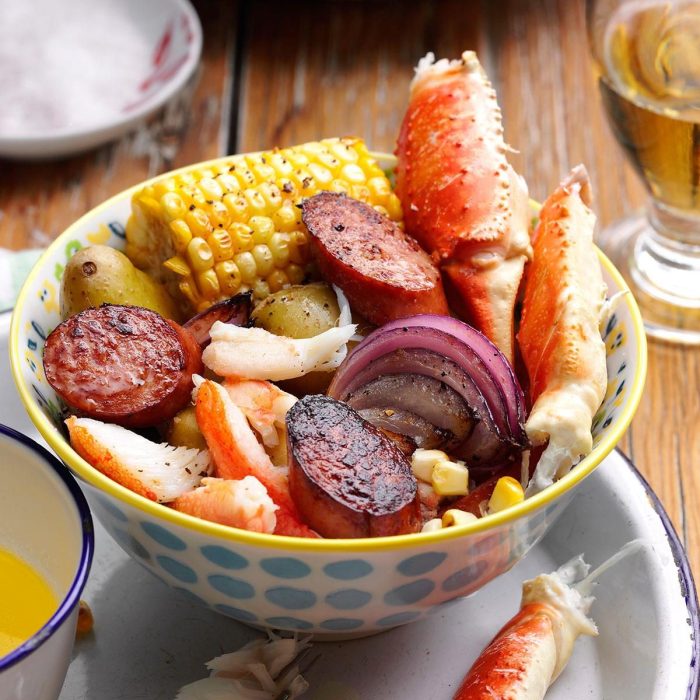
Embark on a culinary adventure with our crab brulee recipe, a tantalizing fusion of delicate crab and rich custard. Discover the techniques and variations that elevate this dish to a masterpiece.
From classic preparations to innovative twists, we’ll guide you through the culinary artistry behind this exquisite creation. Get ready to impress your taste buds and create a dish that will leave a lasting impression.
Culinary Experience

Crab brulee presents a harmonious interplay of flavors and textures that tantalize the palate. The delicate sweetness of the crab contrasts exquisitely with the richness of the custard, creating a symphony of flavors that dance upon the tongue.
Balance of Flavors
The culinary artistry of crab brulee lies in the skillful balancing of flavors. The mild, succulent crab provides a subtle base for the custard’s creamy indulgence. The custard, infused with the essence of crab, envelops the crab in a velvety embrace, enhancing its delicate flavor without overpowering it.
Culinary Techniques, Crab brulee recipe
Creating crab brulee requires a combination of culinary techniques that showcase the chef’s expertise. The crab is meticulously cooked to preserve its delicate texture, while the custard is meticulously prepared to achieve a smooth, velvety consistency. The caramelized sugar topping adds a touch of sweetness and a satisfying crunch, completing the culinary masterpiece.
Recipe Variations: Crab Brulee Recipe
Crab brulee offers a versatile canvas for culinary exploration, allowing for a range of variations that enhance its flavor and presentation.
Experimenting with different crab species can significantly impact the dish’s taste and texture. Dungeness crab, known for its sweet and delicate flavor, is a popular choice, while blue crab adds a bolder, briny note. Softshell crab, with its tender meat, offers a unique twist.
Ingredients Variations
- Cheese:Gruyere, Parmesan, or a blend of cheeses can be used to create a rich and flavorful topping.
- Herbs and Spices:Fresh herbs like thyme, parsley, or chives add aromatic notes, while spices like paprika or cayenne provide a touch of heat.
- Liquids:Cream, milk, or even white wine can be incorporated to adjust the consistency and add depth of flavor.
Cooking Methods Variations
- Traditional Baking:The classic method involves baking the crab mixture in a water bath, resulting in a smooth and creamy texture.
- Sous Vide:Cooking the crab brulee in a vacuum-sealed bag at a precise temperature allows for greater control over doneness and ensures even cooking.
- Pan-Searing:Searing the top of the crab brulee before baking creates a crispy crust that contrasts with the creamy interior.
Presentation Variations
- Individual Ramekins:Serving the crab brulee in individual ramekins offers an elegant and convenient presentation.
- Scallop Shells:Using scallop shells as molds adds a coastal flair to the dish.
- Garnish:Fresh herbs, crab meat, or a drizzle of olive oil can enhance the visual appeal and add a finishing touch.
Innovative Approaches
Beyond these variations, chefs are constantly pushing the boundaries of crab brulee creation. Some innovative approaches include:
- Molecular Gastronomy:Using techniques like spherification or emulsification to create unique textures and presentations.
- Fusion Cuisine:Combining elements from different culinary traditions to create unexpected flavor combinations, such as Asian-inspired crab brulee with ginger and soy.
- Deconstructed Crab Brulee:Breaking down the traditional components and reassembling them in a visually striking and interactive way.
Cooking Techniques

Creating crab brulee involves a meticulous process that demands precision and attention to detail. From cleaning and preparing the crab to crafting the delicate custard base, each step plays a crucial role in achieving the dish’s exquisite texture and flavor.
Cleaning and Preparing the Crab
- Selecting the crab:Opt for fresh, live crabs with a heavy feel and no visible damage to the shell.
- Steaming the crab:Steam the crabs for 10-15 minutes, or until their shells turn bright red.
- Removing the meat:Carefully extract the crab meat from the body and claws, discarding any cartilage or shells.
Preparing the Custard Base
- Mixing the ingredients:Whisk together eggs, cream, milk, and seasonings in a bowl.
- Incorporating the crab:Gently fold the crab meat into the custard mixture.
- Adjusting the consistency:If the custard is too thick, add a splash of milk. If it’s too thin, whisk in an additional egg yolk.
Assembling the Dish
- Preparing the ramekins:Lightly grease individual ramekins with butter.
- Filling the ramekins:Divide the custard mixture evenly among the ramekins.
- Baking the brulee:Bake the brulees in a water bath at a low temperature (around 325°F) for 30-45 minutes, or until they set.
- Cooling and chilling:Allow the brulees to cool completely before refrigerating them for at least 4 hours.
Temperature Control and Timing
Maintaining precise temperature control and timing is paramount for achieving the perfect texture in crab brulee. The low baking temperature prevents the custard from curdling, while the water bath ensures even cooking and a creamy interior. The chilling time allows the brulees to firm up and develop their signature silky texture.
Presentation and Garnishes

Crab brulee is traditionally presented in individual ramekins, showcasing its golden-brown crust and creamy interior. To enhance its visual appeal, consider using different ramekin shapes, such as oval or square, or layering the crab mixture with contrasting colors, such as a layer of roasted red peppers or spinach puree.
Garnishes
Garnishes play a crucial role in complementing the flavors and textures of crab brulee. Fresh herbs, such as chives, dill, or parsley, add a pop of color and freshness. Crispy fried shallots or bacon bits provide a crunchy contrast to the creamy filling.
Foraging for wild edibles can be a rewarding experience, especially when you stumble upon a cluster of bright orange chicken of the woods mushrooms. These fungi, with their meaty texture and savory flavor, make an excellent addition to any meal.
If you’re looking for a delicious way to prepare them, check out this chicken of the woods recipe that will guide you through the process of cleaning, cooking, and savoring this woodland delicacy.
A drizzle of olive oil or a dollop of sour cream adds richness and acidity.
If you’re a fan of mushrooms, you’ll love this chicken of the woods recipe . This edible mushroom has a meaty texture and a slightly sweet flavor, making it a great substitute for chicken in a variety of dishes. The recipe is simple to follow and can be customized to your taste.
Whether you’re a seasoned chef or a novice in the kitchen, you’ll be able to whip up this delicious dish in no time.
Pairing Suggestions

Selecting the right wine to accompany crab brulee elevates the dining experience by harmonizing the flavors and enhancing the overall taste profile. When choosing a wine, consider the acidity, body, and flavor profile to complement the delicate seafood and creamy texture of the dish.
Acidity
Acidity in wine plays a crucial role in balancing the richness of crab brulee. Wines with crisp acidity, such as Sauvignon Blanc or Albariño, cut through the creaminess, refreshing the palate and preventing the dish from becoming overly heavy.
Body
The body of a wine refers to its weight and texture on the palate. Medium-bodied wines, like Chardonnay or Pinot Grigio, pair well with crab brulee. They offer enough weight to stand up to the creamy texture without overpowering the delicate seafood flavors.
Flavor Profile
The flavor profile of the wine should complement the subtle sweetness and briny notes of crab brulee. Wines with citrusy, floral, or mineral notes, such as Riesling or Gewürztraminer, enhance the seafood flavors without overpowering them.
Conclusion

In the realm of culinary delights, crab brulee stands as a testament to the power of innovation and the artistry of cooking. Whether you’re a seasoned chef or a home cook seeking to elevate your skills, this recipe will empower you to create a dish that tantalizes the senses and delights the palate.
So, gather your ingredients, sharpen your knives, and prepare to embark on a culinary journey that will leave you craving more.
Detailed FAQs
What is the ideal cooking temperature for crab brulee?
For a perfect texture, aim for an internal temperature of 165°F (74°C) when measured in the center of the custard.
Can I use different crab species in this recipe?
Yes, feel free to experiment with various crab species such as Dungeness, blue crab, or king crab. Each type will impart its unique flavor and texture to the dish.
How can I enhance the presentation of my crab brulee?
Consider garnishing with fresh herbs like chives or dill, or add a drizzle of lemon zest for a pop of color and brightness.





